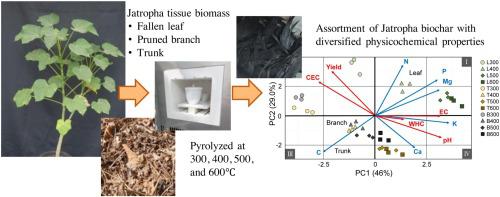Industrial Crops and Products ( IF 5.9 ) Pub Date : 2020-11-05 , DOI: 10.1016/j.indcrop.2020.113060 Takafumi Konaka , Shota Tadano , Tomoki Takahashi , Sony Suharsono , Charles Mazereku , Hisashi Tsujimoto , Tsugiyuki Masunaga , Sadahiro Yamamoto , Kinya Akashi

|
Jatropha curcas (Jatropha) is drought-resistant and produces seed oil that is suitable for biodiesel fuel production. During cultivation, Jatropha produces a large amount of non-oil biomass from fallen leaves and pruned branches; however, their utilization has been largely unexplored. In the present study, we evaluated the potential of Jatropha non-oil biomass as a feedstock for biochar that could be utilized as a soil modifier and fertilizer for sustainable farming. A total of 12 different Jatropha biochars were produced using a combination of three tissue types (leaf, trunk, and branch) and four pyrolysis temperatures (300, 400, 500, and 600 °C), and their physicochemical properties were comparatively analyzed. For each tissue type biochar, a general trend of increasing pH and electrical conductivity, and decreasing yield and cation exchange capacity was observed as the pyrolysis temperature increased. The leaf biochar had significantly lower carbon and higher nitrogen, phosphate, potassium, and magnesium contents than that of the other tissue biochars, whereas the trunk biochar had the highest calcium content among all the biochars. Except for the leaf biochar pyrolyzed at 300 °C, all biochars significantly improved the water holding capacity of silica sand applied at a 1%(w/w) concentration. Pearson’s correlation and principal component analyses highlighted a wide range of biochars with divergent physicochemical properties, which were characterized by nitrogen, phosphate, and magnesium richness in the leaf biochar; and calcium richness in the trunk biochar. Therefore, a specific combination of pyrolysis temperature and tissue type from Jatropha non-oil biomass could serve as a feedstock for tailor-made biochar products for various agronomic needs such as soil modifiers and fertilizers.
中文翻译:

由不同原料组织和生物柴油植物麻风树的热解温度组合而成的多种不同理化性质的生物炭:一项比较研究
麻疯树(麻风树属植物)具有抗旱性,可生产适用于生物柴油燃料生产的种子油。在种植过程中,麻风树从落叶和修剪的枝条中产生大量非油生物质。但是,它们的利用还没有被开发出来。在本研究中,我们评估了麻风树非油生物质作为生物炭原料的潜力,该生物炭可用作土壤改良剂和可持续农业的肥料。使用三种组织类型(叶,树干和分支)和四种热解温度(300、400、500和600°C)的组合,总共生产了12种不同的麻风树生物炭,并对其理化性质进行了比较分析。对于每种组织类型的生物炭,pH和电导率增加的总体趋势是,随着热解温度的升高,收率和阳离子交换能力降低。与其他组织生物炭相比,叶生物炭具有明显较低的碳含量和较高的氮,磷,钾和镁含量,而在所有生物炭中,树干生物炭具有最高的钙含量。除了在300°C下热解的叶片生物炭外,所有生物炭均显着提高了浓度为1%(w / w)的硅砂的持水量。皮尔森(Pearson)的相关性和主成分分析突出显示了具有不同理化特性的多种生物炭,其特征在于叶片生物炭中氮,磷酸盐和镁的丰富度。和树干生物炭中的钙含量丰富。因此,



























 京公网安备 11010802027423号
京公网安备 11010802027423号